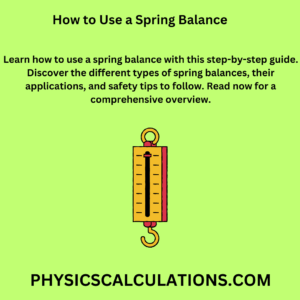Introduction
If you’re looking for a way to accurately measure weight, a spring balance might be just what you need. In this article, we will look at spring balances, including what they are, how they work, and how to use them effectively.

What Is a Spring Balance?
A spring balance is a type of weighing scale that uses a spring to measure weight. It consists of a coiled spring attached to a hook, with a pointer that moves along a calibrated scale as weight is added or removed. Also, the spring’s deflection is proportional to the weight applied to it, allowing for accurate weight measurements.
How Does a Spring Balance Work?
Spring balances work on the principle of Hooke’s law, which states that the force required to extend or compress a spring is proportional to the distance it is stretched or compressed. When we add weight to this tool, it stretches, which causes the pointer to move along the calibrated scale.
Types of Spring Balances
Several types of spring balances are available, each with unique features and applications. Thus, some of the most common types of spring balances include:
1. Hanging Spring Balance
The hanging device is the most common type of spring balance. It features a coiled spring attached to a hook. Additionally, there is a pointer that moves along a calibrated scale as we add or remove the weight.
2. Tubular Spring Balance
The tubular spring balance is similar to the hanging type. However, it has a tubular housing that encloses the spring and scale.
3. Circular Spring Balance
This type of spring features a circular spring housed in a cylindrical case. It has a pointer that moves along a calibrated scale as we add or remove the weight.
How to Use a Spring Balance
Using a spring balance is a simple process. Follow these steps to learn how to use it effectively:
Step 1: Check the Calibration
Before using a spring balance, check its calibration to ensure accurate weight measurements.
Step 2: Attach the Item to the Hook
Attach the item you want to weigh to the hook on the bottom of the spring balance.
Step 3: Read the Measurement
Read the measurement on the calibrated scale where the pointer is pointing. The weight measurement will be in the units specified on the scale.
Advantages of Spring Balances
Spring balances offer several advantages over other types of weighing scales, including:
1. Portability
Spring balances are lightweight and portable, making them ideal for use in a variety of settings.
2. Ease of Use
Using this tool is a simple and straightforward process. This makes them accessible to a wide range of users.
3. Cost-Effective
Spring balances are relatively inexpensive when we compare them with the other types of weighing scales. Therefore, this makes them a cost-effective option for many applications.
Applications of Spring Balances
There are a wide range of applications, which include:
1. Weighing Luggage
We commonly use them to weigh luggage at airports and other travel settings.
2. Weighing Produce
They also play a key role in weighing produce in grocery stores and other food settings.
3. Educational Purposes
Additionally, they help us in educational settings to teach students about weight and measurement. We usually keep them in the physics laboratories for learning purposes.
Conclusion
Spring balances are a simple and effective tool for measuring weight. Whether you need to weigh luggage, produce, or anything else, it can provide accurate weight measurements quickly and easily. With their portability, ease of use, and cost-effectiveness, spring balances are a popular choice for many applications.
Frequently Asked Questions (FAQs)
Q1. What is the maximum weight a spring balance can measure?
A1. The maximum weight it can measure depends on the specific model. Check the specifications of the brand you are using for information on its maximum weight capacity.
Q2. Can we use spring balances for industrial applications?
A2. Yes, spring balances can be used for industrial applications, but it is important to choose the one with a high weight capacity and robust construction.
Q3. Can a spring balance be repaired if it breaks?
A3. In most cases, yes, it can be repaired if it breaks. However, it is often more cost-effective to replace it instead of repairing it.
Q4. How often should a spring balance be calibrated?
A4. The frequency of calibration depends on the specific model and its intended use. It is recommended to check the calibration periodically and have it professionally calibrated as needed.
Q5. Are there any safety precautions to follow when using a spring balance?
A5. Yes, it is important to follow safety precautions when using this tool. This includes not exceeding its weight capacity, and using appropriate protective equipment. Additionally, we need to handle it carefully to avoid injury or damage.
You may also like to read:
How to read a Vernier Calipher
Reference: